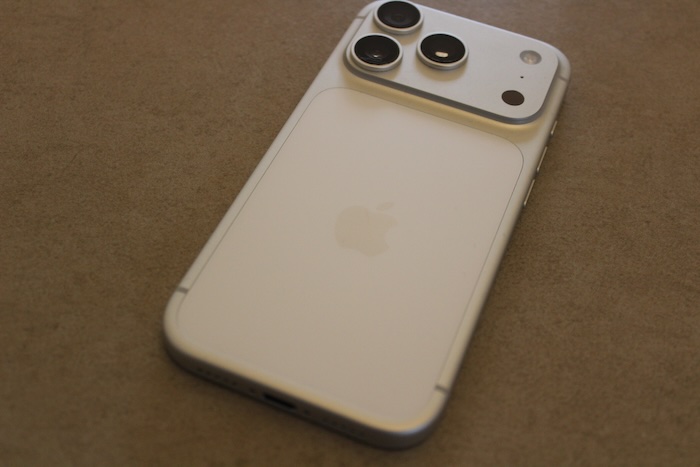Whilst I was thinking, "no new iPhone this year as it'll just be the same old stuff", I was proven wrong.
The iPhone 17 Pro somehow made me reconsider my somewhat naïve yet understandable belief that Apple's innovation was, as I said in my review of the iPhone 15 Pro, stagnant or lacking polished innovation. As a former iPhone 15 Pro user who was generally very happy with it, I'm going to explain why I decided to make an early upgrade and purchase the iPhone 17 Pro.
What's so good about it that made me switch from a 15 Pro?
Ultimately, if, like me, you enjoy an excellent camera experience on your phone, you'll want the absolute latest. My iPhone 15 Pro's camera was excellent, but this goes further.
I always like having an excellent zoom, and my iPhone 15 Pro had a superb zoom, but it wasn't the best. And since I'd heard about the 17 Pro zoom from the keynote, I wanted to try it. Before I actually got the chance to try it, my phone network provider called to ask if I'd like to upgrade. I read a review of the phone and decided that was it. I phoned them back and got it.
Anyway, it wasn't just that that encouraged the change for me; it was the need to update my two-year-old phone, which was ageing rapidly (the battery health was already at 90%), and the design felt dated (despite loving the titanium).
Design
Let's start with the iPhone's design. The 17 Pro comes with a new design, very different to any of the iPhones of the last few years. The most significant change is the new camera plateau, which raises the body around the camera (instead of just having annoying lenses sticking out the back). I genuinely mean this, but I think this is something that really makes the phone look significantly better. It makes the lenses feel like a feature of the rear side of the phone, not just something that has to protrude from the back and look ugly. I really hope Apple keeps this, as I like it a lot (I'd considered switching to Android again for my latest phone, even though I don't think I'd want to, just because I was sick of the iPhone's look).
Speaking of this plateau, it's the device's weakest point and is susceptible to real scratching on its corners. You can watch the Jerry Rig Everything video here.
Next, the elephant in the room, the aluminium. When Apple announced this, I was not too happy. Two years prior, Tim Cook boasted about how good the titanium was—it was light and durable. Then they went backwards. I wasn't sure how this would go down, but I'm delighted to say that after two years of the titanium, I'm pleased with the new aluminium's softness. I've compared both my iPhone 12 mini, an iPhone 11 and this 17 Pro, and you definitely can feel the softer touch of the 17. So let's just put it this way: after using the device for three and a bit weeks, I've fallen in love with the soft touch of the aluminium again.
Not only is the frame aluminium, but the phone is made from one (unibody) body instead of multiple different parts.
The new camera plateau is also a really nice feature, and you'll see why in the review's specifications section if you don't already know. The new camera bump, which Apple is calling the Camera Plateau, finally makes the phone feel a bit less asymmetrical on the rear (well, obviously, the lenses are still left-aligned, but with the flash and sensors right-aligned, Apple has achieved some sense of balance through weight). What I still don't like is that the lens edges still protrude from the phone's base.
Next, on the right-hand side, iPhone users prior to the iPhone 16 will notice the 'new' camera button. Although this was introduced last year, this button deserves a mention. I was very close to getting a 16 last year due to the addition of the camera button. I've never understood why Apple hadn't included one years back. The fabulous button not only launches the camera but also opens the app to ask AI what something is using the camera—I've found this really useful. In addition, the camera button allows you to zoom in and out, change exposure times, and more, and can be customised in the camera settings.
The device is available in several colours, including Cosmic Orange, Deep Blue, and Silver. I chose Silver for a change.
Specifications
The specifications of the iPhone 17 Pro are, as always, top of the range. Powering the device is Apple’s new A19 Pro chip, manufactured using a 3-nanometre process for improved performance and efficiency. Alongside it sits 12 gigabytes of LPDDR5X memory, allowing for smooth multitasking and faster app switching. Storage options range from 256 gigabytes up to 1 terabyte on the Pro model, with the Pro Max variant offering up to 2 terabytes. Connectivity has also been upgraded with Apple’s N1 networking chip, which introduces support for Wi-Fi 7, Bluetooth 6, and Thread connectivity for smart-home integration.
The 17 Pro measures 150 millimetres tall, 71.9 millimetres wide, and 8.75 millimetres thick, with a total weight of 206 grams. The Ceramic Shield 2 front glass provides improved scratch and drop resistance, while the new “camera plateau” design stretches across the top of the rear panel to house the upgraded triple-lens camera system. It retains an IP68 rating for water and dust resistance.
The display remains one of the standout features. Apple has equipped the 17 Pro with a 6.3-inch Super Retina XDR OLED panel that supports LTPO adaptive refresh rates from 1 to 120 Hz. It delivers a resolution of 2622 by 1206 pixels at roughly 460 pixels per inch, ensuring crisp text and vibrant imagery. The screen can reach up to 3000 nits in outdoor conditions, 1600 nits for HDR content, and 1000 nits for typical use. It also supports True Tone, P3 wide colour, and Apple’s Always-On Display mode, all enhanced by a new anti-reflective coating that improves visibility in bright light.
The camera system has been completely reworked. The main wide sensor is 48 megapixels with an f/1.78 aperture and advanced sensor-shift optical image stabilisation. It’s joined by a 48-megapixel ultra-wide lens and a new tetraprism telephoto lens capable of 4× optical zoom and up to 8× “optical-quality” zoom through sensor cropping. Video recording capabilities remain class-leading, offering 4K recording, ProRes, Dolby Vision HDR, and even Log capture for professionals.
The front-facing camera has been upgraded to an 18-megapixel sensor with “Centre Stage” framing and improved low-light performance.
Battery life sees another incremental improvement, with a capacity of around 4000 mAh, translating to roughly 33 hours of video playback. Fast charging delivers up to 50% charge in about 20 minutes with a 40-watt or higher adapter. The move to USB-C continues, offering full USB 3 transfer speeds, while wireless charging supports both MagSafe and the newer Qi 2 standard at up to 25 watts. The bigger battery is due to the Camera Plateau, as Apple has moved much of the logic board into that space, leaving more room for a larger battery. And in all honesty, this works. I now only charge my phone every other day rather than every day.
In terms of connectivity, the iPhone 17 Pro features Qualcomm’s Snapdragon X80 modem, providing fast and reliable 5G performance across a wide range of bands. It also includes support for dual-frequency GPS, NFC, Ultra-Wideband, and even satellite connectivity for SOS and Find My functions. The phone ships with iOS 26, which introduces new security features such as Memory Integrity Enforcement, leveraging both software and hardware defences to make the system more resilient against exploits.
Things I love
My favourite feature of the iPhone 17 Pro is the new camera with the outstanding zoom. The zoom is so good that it enables me to read things across big rooms or check parking meters from a pretty decent distance, allowing me to decide when I'm in my car. I also love the side button for accessing this fantastic camera.
Next is the design. I love this new design that moves away from the standard iPhone design it's had for years. The 17 Pro's new camera notch is a daring change that I believe will be a massive shift in the iPhone's rear design, but its lack of durability hampers it. The glass insert on the back feels nice in your hand, whilst adding an attractive centrepiece to the rear.
The aluminium unibody, despite not being titanium, really adds to the device's rigidity, and I've come to really like it.
Finally, the battery life of this thing is incredible. My phone regularly lasts two days without charging, much like my 15 Pro, which achieved a similar result. In addition, the iPhone 17 Pro's fast charging feature is really brilliant.
The only thing I do not love
Firstly, the anodisation of the camera plateau is very weak, which is very worrying. I cannot understand how a company like Apple would allow this to happen. I'm someone who never puts a case on my iPhone, and I'm cautious with it. But this is something I've got to be aware of, but shouldn't actually have to be.
Conclusion
Firstly, as a former iPhone 15 Pro user, would I recommend the upgrade? Well, probably not is the answer I'd give most people, but also yes to those who want some of these new features, because there have been some changes. However, I'd say quite a lot has actually changed between these models, including a camera button, a larger battery, a bigger camera zoom, a new design, and an aluminium unibody. I'd say this is actually quite a big upgrade, unlike the 15 Pro to the 16 Pro, for example. The choice is really yours.
I do think Apple needs to address the plateau scratching, as it's not acceptable. Other users have reported that the iPhone discolours over time, particularly the orange. Many users, including me, have complained about the lack of a black version. And speaking of which, the dark blue one is the most susceptible to being visibly scratched. Additionally, the iPhone 17 Pro is ever so slightly larger than the iPhone 15 Pro.
Overall, I think the 17 Pro is a great phone, but it's also plagued by a few issues that might make it unsuitable for everyone.







Comments powered by BalfComment